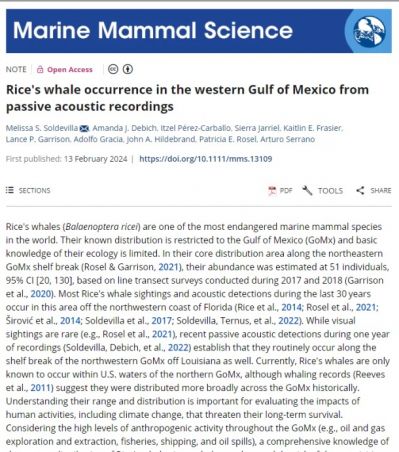Occurrence of Rice's Whale in the Gulf of Mexico
Introduction & Objectives
Rice's whale (Balaenoptera ricei), previously referred to as the Gulf of Mexico Bryde's whale, is estimated to have a population size of 33 individuals in U.S. waters (CV 1.07, Waring et al. 2014), and was recently listed as endangered under the Endangered Species Act (ESA). The majority of modern sightings occur in waters between the 100 – 400 m depths in an area near the De Soto Canyon off northwestern Florida. Occurrence patterns from one year of long-term passive acoustic monitoring and two recent summer and fall visual surveys indicate the whales are found year-round within this primary habitat, but also suggest there may be seasonal movements throughout the habitat, and potentially out of the habitat. High densities of anthropogenic activities occur throughout the GOM, including oil and gas exploration and extraction, fisheries, shipping, and military activities and several of these activities overlap with the whales’ primary habitat. Assessing seasonal distribution and density will improve understanding of potential impact of human activities in the core habitat and assist in developing effective mitigation measures as needed.
This project initially focuses on developing automated Rice's whale call detectors and analyzing existing passive acoustic data collected from the the core habitat to establish an occurrence time-series for understanding seasonal and interannual trends and for future habitat modeling and density estimation. Subsequently, a new data collection effort will be initiated that builds upon these results to better understand temporal variability in occurrence.
Technical Approach
The Southeast Fisheries Science Center and Scripps Institution of Oceanography have been collaboratively deploying long-term passive acoustic monitoring stations at five Gulf of Mexico (GOM) sites since 2010 to monitor the impacts of the Deepwater Horizon oil spill and subsequent restoration activities on cetaceans. High-frequency Acoustic Recording Packages (HARPs), deployed at these five sites, including the De Soto Canyon in the primary Rice's whale habitat, have been continuously recording ambient noise and other acoustic events in the 10 Hz to 100 kHz frequency range, and these 8-year near-continuous recordings are available for analysis to better understand distribution and density trends of cetaceans, potentially including Rice's whale.
Progress & Results
During 2019, the development and characterization of automated detectors of Rice's whale calls was completed. The final spectrogram cross-correlation detectors for long-moan calls and downsweep pulse sequences were optimized to minimize miss rates without introducing an excessive number of false detections. Based on performance on a test dataset, the best long-moan detector had an expected miss rate of 6.5% and false detection rate of 26.4% on the test dataset while the best downsweep pulse sequence detector had an expected miss rate of 12.6% and false detection rate of 69%. Also in 2019, ambient noise analyses were completed on the entire 8-year dataset and evaluated to understand detectability of Rice's whale calls and potential masking effects. Further, the automated detectors were run on the complete 8-year dataset and the detections were validated for the first deployment. See Soldevilla et al., 2020 for additional details.
During 2020, work focused on validating the automated detections of long-moan calls and downsweep pulse sequences from the remaining nine deployments out to June 2018, and results are being prepared in a manuscript to submit for peer-review. Over the eight years of data collected at the De Soto Canyon site from 2010-2018, a total of 628,552 long-moan call detections were manually validated, yielding 466,982 true call detections, and a total of 115,729 downsweep pulse sequence detections were manually validated, yielding 13,36917,449 true call detections. Manual validation results indicate average false detection rates per deployment of the two automated detectors were 29% for long-moan detections and 85% for downsweep pulse sequence detections. True detections of both long-moan and downsweep pulse sequence call types were detected in all seasons and all years at the De Soto Canyon HARP site.
A final goal for work during 2020 was to begin a new data collection effort to better understand the observed intra-annual variability in Rice's whale call occurrence with respect to the entire core habitat by expanding passive acoustic monitoring to an additional 17 sites and providing further information to interpret the changes seen at the De Soto Canyon HARP. Deployment of SoundTrap ST500 PAM devices took place in May of 2021 and will record continuously for 6 months at a time, and will be in service for nearly two years. Concurrently, a long-term HARP will record continuously at the De Soto Canyon site in the core Rice’s whale habitat over the August 2020 to July 2025 period.
Data undergoes a validation process to determine true Rice’s whale calls. The validation process has been completed for 13 of the 15 moorings from November 2021 to September 2022, yielding a total of 183,102 true and 24,566 possible long-moan call detections out of 405,212 auto-detections validated to date. During the November 2021 to April 2022 period, true detections of Rice’s whale long-moans occurred at all 13 of the manually validated sites, ranging from 368 to 50,695 calls per site. Similar to the May to September 2021 data, higher numbers of detections occurred at the inshore sites. Across the 13 validated sites, the daily occurrence of Rice’s whale long-moan calls varied by site as well, with calls present on 29 to 99 percent of days per site over the November 2021 to April 2022 period.
Data recovered from the April to September 2022 period were corrupted but recovered and are currently undergoing decompression, decimation, and automated detection-processing steps.
Project Information
Location: Northern Gulf of Mexico
Timeline: 2019-2023
Funding: FY18 - $78K, FY19 - $395K, FY20 - $250K, FY22 - $59K
Points of Contact
Principal Investigator
Dr. Melissa Soldevilla
NOAA Southeast Fisheries Science Center
Project/Program Manager
Joel T. Bell
NAVFAC Atlantic
Environmental Conservation, Marine Resources Section
Deputy Program Manager
Jackie Bort
NAVFAC Atlantic
Environmental Conservation
Marine Resources Section
Reports & Data
2019 Technical Progress Report
2020 Technical Progress Report
2021 Technical Progress Report


